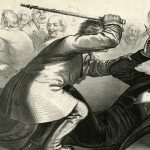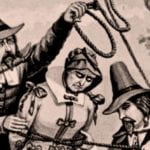 History
History  History
History  Technology
Technology Top 10 Everyday Tech Buzzwords That Hide a Darker Past
 Humans
Humans 10 Everyday Human Behaviors That Are Actually Survival Instincts
 Animals
Animals 10 Animals That Humiliated and Harmed Historical Leaders
 History
History 10 Most Influential Protests in Modern History
 Creepy
Creepy 10 More Representations of Death from Myth, Legend, and Folktale
 Technology
Technology 10 Scientific Breakthroughs of 2025 That’ll Change Everything
 Our World
Our World 10 Ways Icelandic Culture Makes Other Countries Look Boring
 Misconceptions
Misconceptions 10 Common Misconceptions About the Victorian Era
 Mysteries
Mysteries 10 Strange Unexplained Mysteries of 2025
 History
History 10 Things You Didn’t Know About the American National Anthem
 Technology
Technology Top 10 Everyday Tech Buzzwords That Hide a Darker Past
 Humans
Humans 10 Everyday Human Behaviors That Are Actually Survival Instincts
Who's Behind Listverse?

Jamie Frater
Head Editor
Jamie founded Listverse due to an insatiable desire to share fascinating, obscure, and bizarre facts. He has been a guest speaker on numerous national radio and television stations and is a five time published author.
More About Us Animals
Animals 10 Animals That Humiliated and Harmed Historical Leaders
 History
History 10 Most Influential Protests in Modern History
 Creepy
Creepy 10 More Representations of Death from Myth, Legend, and Folktale
 Technology
Technology 10 Scientific Breakthroughs of 2025 That’ll Change Everything
 Our World
Our World 10 Ways Icelandic Culture Makes Other Countries Look Boring
 Misconceptions
Misconceptions 10 Common Misconceptions About the Victorian Era
 Mysteries
Mysteries 10 Strange Unexplained Mysteries of 2025
Ten Terrifying and Formidable Women from American History
America has no shortage of scoundrels and scofflaws. Throughout the country’s history, countless men have grabbed public attention with daring and dangerous behavior. Famous outlaws and criminals have won the hearts of adoring female fans and inspired nationwide reactions. Vicious and violent gangsters in several eras have scared Americans straight. Others kept the entire nation on the edge of its proverbial seat with tales of awful exploits.
But what about bad women? Surely, in the 200-plus-year history of the United States, it hasn’t only been men who have terrorized and domineered over the country and its far-flung inhabitants, right?
In this list, you’ll learn more about ten terrifying and formidable women who wreaked havoc on America. Not all these women were as outwardly violent as the country’s most dangerous men—although some were. Some were domineering and politically astute. Others were aggressive and demanding of their desires. Still more were shrewd and cunning with how they got what they wanted.
But one thing is for sure: You wouldn’t have wanted to come across any of these ten terrible women during their torrid lives. Though many of these women have been dead for decades or longer, they still strike fear into the hearts of historians. The tales of these ten vicious vixens will remind readers that men don’t have a monopoly on sadistic violence, vengeful plots, or acts of terror…
Related: Top 10 Amazing Women Of The Ancient World
10 Griselda Blanco
Griselda Blanco may have looked matronly, but she was actually one of the foremost participants in the cocaine trade in Miami in the 1970s and 1980s. The Colombian-born woman grew up in poverty in South America but wanted more for her life. Even at a young age, she was reportedly sadistic. One legend tells the tale of her allegedly kidnapping and killing a boy in Colombia when she was just 11 years old. By her early adult life in the 1970s, she found the drug trade as a lucrative outlet.
In that era, she connected with famed drug trafficker Alberto Bravo. The two began importing large quantities of cocaine into the United States. Before long, Bravo was murdered—allegedly in a hit ordered by Blanco—and she took over the drug trade. Soon, she started leaving behind a trail of dead husbands across Miami. Other drug competitors were turning up dead in strange places too. Cops couldn’t prove Griselda was behind it all, but the streets knew what was going on. She earned herself the nickname “Black Widow” for all the deaths. As the 1980s began, her drug trade exploded across South Florida. She began wiping out competitors in droves and was, for a while, the one dealer on top of the heap during the “Cocaine Cowboy Wars.”
After years of drugs, murder, and mayhem, the feds eventually caught up to Griselda. In 1985, she was found guilty of a series of drug-related charges. Prosecutors couldn’t pin any murders on Blanco, so they couldn’t lock her up for life. But a decades-long prison sentence was enough to shut down her operation and get her off the streets. By 2004, Blanco was done with prison and back out on the street. She had been deported to her native Colombia by then.
Done with drugs and Miami, it appeared like Blanco was ready to calm down. In Colombia, she reportedly retired from criminal life and enjoyed her time in old age. But the old rivalries of the drug trade would soon catch up to her. In 2012, as she was walking out of a butcher’s shop in the city of Medellín, she was shot and killed by an assassin driving by on a motorcycle. Her manner of death was darkly ironic: It was Griselda Blanco herself who first perfected the motorcycle assassin hit-and-getaway scheme.[1]
9 Iva Kroeger
You might have thought Iva Kroeger was a sweet grandmother just by looking at her. But the old woman—born Lucille Hopper and first arrested way back in her youth—had developed a long, sordid string of criminal affairs by old age. She lied her way into situations by claiming to be a military nurse. Then, she would rack up debts and covertly steal things she wanted. When the heat got too stifling, she would conveniently skip town and move on to the next con.
For years, she lived like that. By the time she married a man named Ralph Kroeger in San Francisco in 1954, she was going by the name “Iva.” Ralph appeared to have been something of a debt artist himself, and by 1961, the duo changed their last name to Long and moved into a northern California hotel. There, Iva quickly developed a close relationship with Mildred and Jay Arneson, who owned another hotel right across the street. After a few weeks getting closer and closer, Mildred and Jay suddenly went missing. Nobody knew where they were or when they would be back.
When cops finally closed in to investigate, they found Iva behind the desk at the hotel. She told officers she was the new proprietor. When cops asked where Mildred and Jay had gone off to, Iva played dumb. She said they simply left—but, of course, not before signing over the deed to the hotel to Iva. Cops were suspicious but had nothing else to go on. Then, they had even more questions for Iva after odd handwritten notes purported to be from Mildred were magically delivered to officers one night.
After a long and ineffective investigation, cops finally got a search warrant for the hotel property. While searching around out back, they found Mildred and Jay. The couple had been killed and buried in shallow graves in the motel’s dank garage. Iva had long since left town, but luckily, law enforcement soon caught up with her. Cops in San Diego found Iva while she was trying to make a run for the Mexican border. She was arrested and jailed as newspapers up and down the West Coast seized on her sordid story.
At trial, she did her best to establish an insanity defense, but the jury didn’t buy it. Iva was found guilty of murder and imprisoned. But less than two decades later, she was granted parole! Released from jail by 1975, she moved across the country and carried on her criminal ways. It was mostly petty stuff, but in 1987, she was accused of making threats to murder someone in Florida. By 2000, Iva died in obscurity. Still, for quite a while, she was northern California’s most feared female criminal and fugitive murderer.[2]
8 Bonnie Parker
Who hasn’t heard about the famed exploits of Bonnie and Clyde? While outlaw Clyde Barrow gets most of the attention as a gun-wheeling thug, his luscious love was no wilting violet herself. Born in the slums of West Dallas, Bonnie Parker dreamed of acting and poetry while growing up. Her romantic streak was belied by a dark undercurrent, though. Like Barrow, Parker was deeply affected by her family’s difficult experience during the Great Depression.
As Clyde worked behind the scenes to develop a bank-robbing gang, Bonnie was right there with him. No matter her desires for acting fame or literary renown, the more pressing concerns of money and food called. And she was no slouch when it came to doing what needed to be done to score some quick cash.
Clyde Barrow’s notorious gang ended up killing 13 people during their long run of 1930s robberies and banditry. Historians have long since debated whether Parker was specifically involved in any of the killings. Ultimately, most believe she didn’t actually pull the trigger to commit murder. But she was there all the same, helping stash cash, steal getaway cars, and run the remarkably dangerous criminal enterprise. The breathless media coverage of the time only heightened her profile too.
Many people all across America idolized Parker for both her beauty and her brazen behavior. Her romance with Clyde surrounding such a murderous rage made them a unique Robin Hood-type couple that would forever be part of American lore. Of course, it didn’t hurt that she infamously posed against a stolen car with guns by her side and a cigar in her mouth. Bonnie Parker perfectly looked the part of America’s first female gangster—and she had a crew dangerous enough to back her up.[3]
7 Kate Bender
The Bender family was a notoriously murderous crew out on the Great Plains of Kansas in the late 19th century. There was John Bender Sr., a German immigrant with limited English skills, and his son John Jr. The family’s mother, Elvira (or Almira), was also said to be remarkably limited with her English—and mean as could be to boot. But the family ran a successful boarding house seeking traveling and wayward men coming through rural Kansas for many years.
The draw was simple: 23-year-old Kate Bender was pretty, charismatic, and enticing. That she knew English and understood how to attract American men didn’t hurt, either. By 1871, the Benders had a reliable room to let in their rural Kansas home. They began advertising in newspapers, and men began showing up. One by one, men checked in to stay. One by one, men were mesmerized by Kate’s beauty and social graces. And one by one, these men kept disappearing suspiciously on their way along the famed Osage Trail.
For a while, it looked like Kate and her family might just get away with it. But a man back east named Dr. William Henry York began to follow up in earnest after several former neighbors apparently never arrived at their westward destinations. York went out to Kansas to look for his former friends and soon came upon the Benders. Then—you guessed it—he went missing too. But York’s apparent death was not in vain. His brother Alexander was following the man’s travels closely.
When William went AWOL, Alexander trekked to the Benders’ home to get answers once and for all. But when he got there, they were all gone. Kate and her crew had packed up and left. Police stormed in and found the remains of a dozen men on the property. Suddenly, it became clear what had happened to these unfortunate souls. But justice wasn’t meant to be.
Kate’s family had disappeared without a trace, and nobody knew where to find them. For years after, Kate and the Bloody Benders were reportedly sighted here and there around the American frontier. But no reports ever came to fruition. The beautiful young woman and her serial murdering clan simply disappeared into thin air—perhaps to kill again somewhere else.[4]
6 Belle Gunness
Kate Bender wasn’t the only wayward woman who used pioneers’ dreams as a pretense for murder. In the early 20th century, Belle Gunness became a notorious lonely hearts killer in Indiana. She used her farm in the town of LaPorte to attract unsuspecting men. And she, too, was ultimately able to escape justice.
Born in Norway in 1859, Gunness came to the United States in 1881. After working as a servant for a few years, she married another Norwegian named Mads Sorensen. Not long after they wed, their Chicago home burned to the ground. That fire netted a nice insurance payout for Mads. Then, their general store caught fire, too—and another insurance payout came in.
Following those paydays, the couple moved to Austin, Illinois. They fostered children there but without great success. At least two children died suspiciously while under their care in the late 1890s. Then, at the turn of the century, Mads himself kicked the bucket. As it turned out, his death came on the only day where his two life insurance policies overlapped—netting a double payout for his grieving wife.
Flush with cash and on her own, Gunness moved to LaPorte, Indiana, along with her surviving foster kids. As she settled on a farm there, she began contacting Norwegian immigrants who were lonely and missing home. She told them she was a widow seeking a man to be part of her life and help her with the farm. More than a dozen men fell for the apparent ruse, showed up in Indiana, and were never heard from again.
One man named Andrew Helgelien lost most of his considerable fortune to Belle before vanishing. His suspicious family members eventually tracked his trail to the farm in LaPorte. But in 1908, as they began to investigate closely, the farmhouse caught fire. A total of seventeen buried bodies were found underneath the charred remains. They included at least 13 men in various states of decomposition. Other bodies appeared to be of Belle and her foster children. But investigators quickly realized the woman’s body they found was missing its head. Plus, it was of a far smaller woman than Belle had been. Cops in LaPorte slowly realized what happened: Belle appeared to have faked her own death and vanished into the wilds. She was never heard from again.[5]
5 Bernardine Dohrn
Believe it or not, one of the most dangerous women in America in the 1970s was a mild-mannered law school graduate named Bernardine Dohrn. Her backstory wouldn’t lead one to that impression. Dohrn graduated from the University of Chicago in 1964, then earned a law degree three years later. But by 1968, she was organizing student revolts at Columbia University in New York City. And her taste for radical politics was only deepening.
In 1969, she returned to Chicago and helped form a leftist activist group that came to be known as Weather Underground. That year, the group laid out their plans for a “Days of Rage” protest. They wanted a head-to-head fight with the Chicago Police Department. Fortunately for Dohrn and the cops, that protest fizzled out before the battle could begin. Still, she was arrested for breaking through a police blockade in her attempts to incite a riot. The “Days of Rage” were nothing compared to what was to come, though.
In 1970, Dohrn went even deeper in her anti-government rhetoric. She asserted that Weather Underground needed to start bombing government buildings to prove how strongly it was committed to an anti-capitalist agenda. Dohrn helped plan bombing runs and mail attacks for the rest of that year. It all came to a head when three other Weather Underground members were killed in accidental bomb explosions.
The blasts had been intended for Fort Dix but never made it. Still, the FBI knew it was time to nip things in the bud. They put an arrest warrant out for Dohrn. To drum up awareness of the investigation, they even placed Dohrn on their Ten Most Wanted List. For years, she was the only woman on that list and, thus, the most wanted woman in America. Dohrn went into hiding. She wasn’t heard from for more than a decade after.
Then, suddenly, she resurfaced in the early 1980s. She was married by then and had three children of her own. The government had moved on to other prosecutions by that time. So they chose to only hand out a $1,500 fine and levy three years of probation in her case. Dohrn ended up making good in life after all that activism work too. She became a professor of law in her later life, teaching what she’d previously studied to other future students. Her son has since followed in her footsteps as a professor at Northwestern University as well.[6]
4 Mary Mallon
By this point in the list, we’ve learned all about woe-inducing women and murderous mavens intent on harming others purposely—often for profit. But what happens when the terrifying woman doesn’t think she’s committing an evil act at all? Such was the case with Irish-born immigrant Mary Mallon in the late 19th century. You might know her best as “Typhoid Mary,” and her cautionary tale is unsettling on several levels.
Mary was born in Ireland and moved to New York City in the late 1800s, where she worked as a cook and servant for several families. While in her domestic position, she became known for her rare trait of being a completely asymptomatic carrier of typhoid. New York was being ravaged by the bacterial disease at the time. Mary could spread it to others—but it didn’t affect her personally.
As typhoid ripped through NYC, public health officials began tracking down the spread. One rich family that had been affected even hired a sanitary engineer to look into its cause. He traced the disease back to Mary Mallon. Soon, city officials were at her doorstep demanding she quarantine herself.
By 1907, Typhoid Mary was in full quarantine. Three years later, a new health commissioner demanded she never again work as a cook or servant. But Mallon didn’t listen. After that initial typhoid scare died down, she returned to work at a maternity hospital. Working as a cook there, she spread typhoid around to several patients who were already in vulnerable states with their immune systems. As the death toll rose once again, New York officials tracked down Mary and banned her from the premises.
Then, she was ordered to remain in quarantine for the rest of her life. The second time around, this ban was far more strictly enforced. Mary ended up dying alone in quarantine in 1938. She was understandably upset at her life being limited in such a way. Still, health officials asserted she simply posed too great a threat to those around her. Now, following COVID’s fiery spread around the world, Mary’s story of infection and quarantine seems more applicable today than ever.[7]
3 Delphine LaLaurie
Delphine LaLaurie was a Creole woman who was a well-known socialite in 19th-century New Orleans. She resided in the affluent French Quarter with her third husband, Dr. Leonard Louis Nicolas LaLaurie. Like many other residents at the time, they had multiple slaves working at their estate. However, rumors of the mistreatment of enslaved people by the LaLauries had been circulating since the late 1820s.
In 1834, firefighters arrived at the LaLaurie mansion to put out a horrible inferno. They found an elderly woman chained to the kitchen stove. She claimed she had intentionally set the fire to kill herself and alleged she had been mistreated. An investigation uncovered a horrific scene in a hidden chamber deep in the bowels of the home. There, seven slaves had been mutilated and chained against their will. Multiple graves were also found in the mansion’s yard. The exact number of bodies was unclear due to conflicting news reports. But rumors around New Orleans held that dozens had died at the evil socialite’s hands.
After the fire, tales of Madame LaLaurie chasing a young slave girl surfaced too. As the legend went, the girl’s fatal fall from the roof came about after LaLaurie’s advances. The accuracy of that event was never proven beyond a doubt, but the rumors stuck. Plus, the discovery of the mutilated and chained slaves in the home’s secret chamber confirmed the rumors of mistreatment. Soon after the fire was put out, an outraged mob gathered outside the LaLaurie mansion.
Madame LaLaurie escaped the mob’s wrath by fleeing the city. She went into hiding and purportedly died in France in the 1840s. Her mansion remains standing today. It has become a popular tourist attraction, even though the owner has made it clear they have no interest in allowing visitors inside. Even now, though, the LaLaurie mansion serves as a haunting reminder of New Orleans’s troubled and disturbing history.[8]
2 Emma Goldman
Emma Goldman was a woman ahead of her time. She was a strong and opinionated figure who was both loved and loathed for her radical views. Born in Russia in 1869, Goldman was heavily influenced by the social and political turmoil of her childhood. In her teens, her family chose to move from Russia to the United States. It was here after 1885 that she first became horrified by the oppressive conditions faced by laborers across the country. She was also repulsed by the violent pushback business owners showed against labor organizers.
These experiences quickly led her to become an outspoken anarchist. Very soon, Goldman’s anarchism made her a target of government officials. They viewed her as a dangerous and subversive figure. Her charismatic personality, eloquent speeches, and willingness to engage in violence made her an even greater threat. In 1892, she was involved in the attempted assassination of businessman Henry Clay Frick. Several years later, she was even implicated in the tragic murder of President William McKinley.
Despite her radical views and involvement in violent acts, Goldman was a fierce advocate for freedom of speech. She also supported other notions which were shocking at the time, including women’s suffrage, labor union participation, and sexual freedom. She was frequently arrested and even banned from lecturing on these topics. State and local governments and business owners alike began to greatly fear Goldman. However, this only strengthened her resolve to fight for her beliefs.
Today, Goldman’s legacy is complex. Her advocacy for social and political change paved the way for future generations of activists. Her commitment to freedom of speech and other progressive ideals inspired many. Plus, her outspoken nature served as a reminder that sometimes, it takes a loud and controversial voice to effect real change. However, her reign of activist terror shot fear into the hearts of capitalists and made her one of the most targeted women in the early 20th century prior to her death in 1940.[9]
1 Mother Jones
Just like Emma Goldman, the legacy of Mary Harris Jones is one of a fierce and fiery labor organizer and social activist who struck fear into the hearts of business owners and lax government officials. Best known as Mother Jones, she was a labor organizer and social activist who fought for workers’ rights in the U.S. in the late 19th and early 20th centuries.
Born in Ireland in 1837, Jones emigrated to Canada with her family as a child. Soon after, she moved to the United States, where she married and had four children. Tragedy struck when her husband and all four of her children died from yellow fever in 1867. Jones relocated to Chicago to start anew. Sadly, her nascent sewing business was destroyed in the Great Fire of 1871. Determined to continue her work, Jones became involved with social organizations and labor organizing.
By the end of the 19th century, she had become a veteran of hundreds of worker strikes against big business. In West Virginia, Jones was involved in a violent coal workers’ strike that led to her being sentenced to 20 years in prison for conspiracy to commit murder. The governor later commuted her sentence, but her activism habit stuck.
Despite her boundary-pushing work, Jones was known to be surprisingly conservative in other areas. She opposed women’s right to vote and said suffragists were only reinforcing the class stratification she vehemently opposed. Nonetheless, Jones’s legacy lives on as a fierce advocate for workers’ rights. In her life, she was known as the “most dangerous woman in America” due to her fearless advocacy for justice. That legacy continues to inspire social justice activists today.[10]








